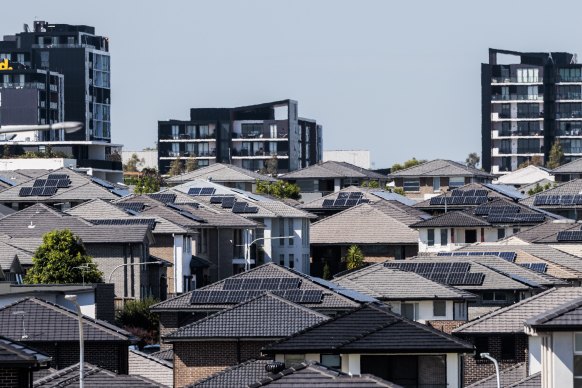“Sydney’s housing costs could be lowered by allowing apartment heights [or floor-space ratios] above current levels, especially in inner suburbs,” the report stated.
“Building up is especially efficient in inner suburbs because it lets us more easily locate our homes close to jobs and amenities, or close to transport hubs that can move people there more quickly.”

The report urges the NSW government to shift focus from new developments in western Sydney to increased density in the CBD and inner suburbs.Credit: Brook Mitchell
The commission’s intervention has been welcomed by Planning Minister Paul Scully, who argues Sydney’s west has been forced to carry too much of the housing burden. The government’s current forecasts indicate NSW will fall short of its five-year housing targets by about 134,000. The vast bulk of existing targets have been focused on the western suburbs.
Scully said he agreed with the commission that more homes were needed closer to jobs and services.
“This means we need to build homes closer to the city as part of major train station developments such as Sydney Metro,” he said.
“We cannot continue to add another street every other week to our urban fringe.
“The size of our housing shortfall is now so large that all communities need to take their share to address the problem.”
The report also paints a dire picture of Sydney’s housing approvals. Since 1992 NSW has built about six dwellings per 1000 people each year on average, compared to about eight or nine in Victoria and Queensland.
That lag has seen the median Sydney house price relative to the gross salary of a mid-career teacher more than double since the turn of the century.
The commission used price-to-cost ratios – how much it cost to build apartments versus the return on a sale – to find unmet demand is far higher in Sydney’s eastern suburbs, north shore, inner west and CBD, compared to the south-west, where there was “relatively little excess demand”.
“We’ve got to build both, but … we haven’t focused as much on building closer in and we’ve got to legitimise that and get more of that done,” he said.
While opponents to development in more affluent inner-city areas often focus on their existing density, the report found inner areas of Melbourne and Brisbane have “considerably higher population density” than Sydney.
Loading
And while Achterstraat says affordable housing targets are important, not enough attention is paid to the “filtering” effect of building for the top end of the market. Building more expensive units in the inner city, he said, would cater for better building design while also freeing up existing stock for middle and lower income families.
“The reverse is happening at the moment. Higher income people are priced out of the really expensive places, so they’re bidding against middle income people and then forcing up the prices,” he said.
The Morning Edition newsletter is our guide to the day’s most important and interesting stories, analysis and insights. Sign up here.
